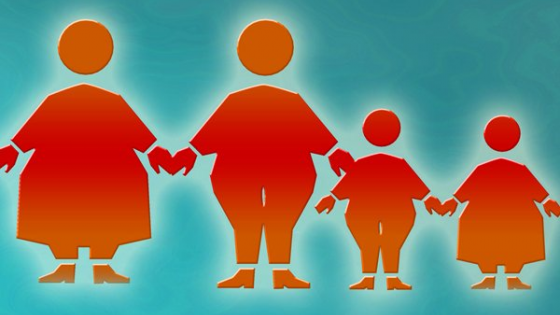Overweightness and obesity (extreme overweightness) in children is of growing concern. Evidence from the Health Survey for England suggests that, averaged over the three years 2010 to 2012, the prevalence of overweightness among 2-10 year-olds was as high as 26%, and obesity 13%. The respective numbers for 11-15 year-olds are 35% and 9%.
A major problem for policy intervention is the identification of the relative importance of hereditary factors and environmental ones, and recent estimates of the transmission of obesity vary from 20% to 60% (Elks et al. 2012). Children may consciously or unconsciously observe and model their parents, especially with regards to fitness and to food consumption. Indeed, there is evidence that children’s caloric intake, diet habits, level of physical activity and health behaviour in general are, at least partially, dictated by their parents’ health behaviour and culturally determined social norms.The policy implications are large. If a cultural or environmental component in transmission is the major driver, then there is room for policy intervention, but that component needs to be identified so that policy can be properly targeted.
New evidence from England
In our study, we estimate the parental cultural influence on children’s overweightness in England (Costa-Font et al. 2015). One previous study found little evidence that overweightness is transmitted from parents to adopted children (Sacerdote 2007), but it relies only on Korean adoptees in the US, and Korean rates of obesity and overweightness are among the lowest of the world (OECD 2015). Instead we draw upon all the 13 waves of the Health Survey for England to construct a unique dataset of children living in homes with either two biological parents or two adoptive parents.
The analysis is conducted making use of a uniquely constructed dataset of English adoptees from 1997 to 2010. These data allow us to identify the magnitude of cultural transmission of overweightness and obesity, by quantifying the differences in the degree of transmission from parents to children, and drawing on clinial measurements of overweightness rather than self-reports. Besides the nature of the parent-child relationship, the data include information on a range of children’s and parents’ characteristics, on parental lifestyles, and on validated anthropometric records on children´s overweightness.
We base our empirical approach on a theoretical model of health production, by which children’s overweightness depends on the overweight or obese status of their parents, and thus implicitly on the parents’ lifestyle choices and net caloric intakes. We follow an empirical strategy that has taken selection issues into account.
Our results reveal that when both adoptive parents are overweight, the likelihood of an adopted child being overweight is between 10% and 20% higher than when they are not, a result that we attribute to cultural or environmental transmission of overweight. We also find that the cultural transmission of overweightness from parents to children is not aggravated by having a full-time working mother. Nevertheless, for natural children only, having a full-time working mother does significantly increase the positive effect of having an obese father on the likelihood of the child being overweight or obese, consistenly with other studies (Costa-Font et al. 2013).
Our results indicate quite strongly that there seems to be a powerful cultural transmission of overweightness inter-generationally, in addition to that resulting from the genetic links, even when we control for sample selection, employing two different strategies using observables. For obesity the results are less strong, but both parents being obese or the father alone being obese increase the probability of observing an overweight and/or obese child even when they are not genetically related.
Policy implications
Our results suggest that that there is room to design policies to tackle children’s overweightness and obesity by influencing parental overweightness and their lifestyles, and that ideally both parents should be influenced for most effectiveness. Otherwise problems of children overweightness are likely to persist. Overweightness is passed through generations, and the pathway seems to be primarily driven by the children’s environment. In contrast, and consistently with the behavioural generics literature, obesity exhibits a highly genetic component.
References
Costa-Font, J, M Jofre-Bonet, and J Legrand (2015), “Vertical Transmission of Overweight: Evidence from English Adoptees”, CESifo Working Paper Series 5351, CESifo Group Munich
Costa-Font, J, and J Gil (2013), “Intergenerational and socioeconomic gradients of child obesity”, Social Science and Medicine, 93: 29-37
Elks, C E, M den Hoed, J H Zhao, S J Sharp, N J Wareham, R J Loos, and K K Ong (2012), “Variability in the heritability of body mass index: a systematic review and meta-regression”, Front Endocrinol, 3: 29
Sacerdote, B (2007), “How Large Are the Effects from Changes in Family Environment? A Study of Korean American Adoptees”, Quarterly Journal of Economics 122: 119-157






